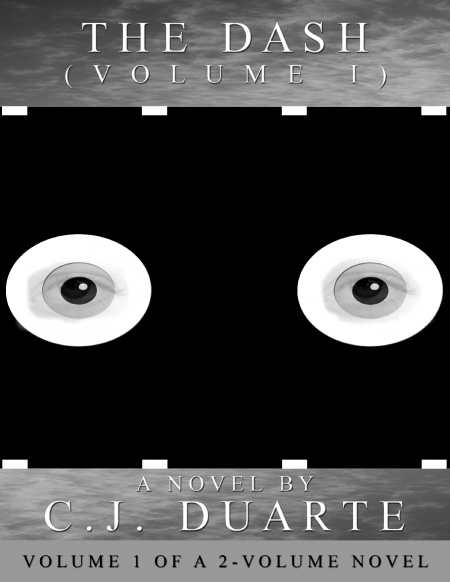The Dash
Volume I
“It’s sort of like a dream—only, it’s still happening. And it’s almost at the point where it doesn’t even bother me anymore. You accept these severe limitations, including the possibility that you may not even be experiencing all of this.” That’s how Canadian Claire Bead, the central character in C. J. Duarte’s first novel, The Dash, attempts to explain her muddled mental state in this parallel-world fantasy.
In a brief first segment, Claire, a frustrated writer desperate for new ideas, finds possibility in the enigmatic phrase, “the train doesn’t stop here anymore.” Her desperation leads to her apparent suicide as she jumps off her apartment’s window ledge. She passes out, then awakens with amnesia in Cloak Valley, a place literally “cloaked” in black, white, and shades of gray. Almost as soon as she arrives, dressed in her nightgown, she meets Art Rukin, a bearded man with shining eyes, to whom she feels a strong attraction. Art gives her sanctuary and becomes a Virgil to Claire’s Dante.
Cloak Valley is populated by a host of odd types, from the blandly pleasant minister to the complex and contradictory Des Moines clan. Over the valley hangs the shadow of Zolltech Inc., which is run by well-known scoundrel Byron Zolltech. Claire, like everyone else, is soon under the sway of the eerie dominance that Zolltech seems to impose over the lives of those in the valley.
Art is also a writer suffering from writer’s block. He disturbs Claire by alluding to a mental image of a “roundhouse” that seems to connect to the previous life she struggles to recall. Their shared world closely parallels the world Claire previously inhabited: Its denizens commemorate Christmas, computers are used, the seasons are the same, if colorless. By the end of the saga, Claire has settled into her new life—or her afterlife, or maybe a dream—in the colorless world of Cloak Valley.
Despite the fact that in the main, Duarte presents fictional situations that are both intellectually ticklish and psychologically emotive, The Dash often reads like a series of random stories, choppy and disconnected. Even when the focus returns to Claire, the plot is slowed by burdensome detail and far too much incidental conversation between Claire and Art. A too-long chapter, for example, describes every moment of a simple lunch at home, almost as if we were watching a video of the events of someone’s private life. And occasionally, amid Duarte’s generally competent prose, ungainly sentences crop up, such as, “Claire allows herself to trail off, much to Art’s lack of surprise,” and “Temporarily unbeknownst to her, however, this will all change in but a moment.”
Duarte’s work will doubtless resonate with readers of the fantasy genre who thrive on a diet of imaginary realms where unexplained incongruities provide intellectual spice and myriad zany characters add to the pungency of the stew. For such a hungry audience, Duarte’s creation will definitely satisfy.
Reviewed by
Barbara Bamberger Scott
Disclosure: This article is not an endorsement, but a review. The publisher of this book provided free copies of the book and paid a small fee to have their book reviewed by a professional reviewer. Foreword Reviews and Clarion Reviews make no guarantee that the publisher will receive a positive review. Foreword Magazine, Inc. is disclosing this in accordance with the Federal Trade Commission’s 16 CFR, Part 255.

